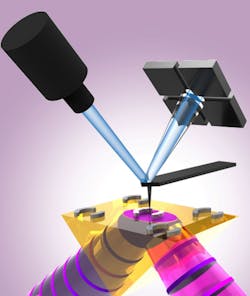Characterize Plasmonic-Resonator Spectra at Nanoscale Resolution
Further advances in nanotechnology require measurement methods for characterizing materials at appropriately small length scales. On that front, scientists recently found that photothermal induced resonance (PTIR) can be used to characterize individual plasmonic nanomaterials to obtain absorption maps and spectra with nanometer-scale resolution. Nanostructuring of plasmonic materials enables the engineering of their resonant optical response, opening the door to applications that would benefit from enhanced light-matter interactions, such as sensing, therapeutics, photovoltaics, and photocatalysis.
As part of the study, researchers from the National Institute of Standards and Technology (NIST) Center for Nanoscale Science and Technology (CNST) and the University of Maryland applied two methods to collect nanoscale absorption information. First, they mapped infrared absorption while scanning a tip on a sample under constant wavelength illumination. Then, using tunable lasers, they measured location-specific absorption spectra while sweeping a laser across infrared wavelengths ranging from 1.55 µm to 16.00 µm. Armed with the data acquired via the nanoscale infrared absorption spectra of gold resonators, the research team could interpret the images and guide further experiments.
PTIR measures light absorption in a material through the use of a wavelength-tunable laser and a sharp tip in contact with the sample that acts as a local detector. Unlike other methods, the PTIR tip is passive and subsequently doesn’t interfere with the measurement. This means that light absorption in a sample can be measured directly without the need for a model of the tip or prior knowledge of the sample. Consequently, plasmonic materials that have large thermal conductivity and relatively small thermal expansion coefficients, such as gold, can be accurately measured.
About the Author
Iliza Sokol
Associate Digital Editor
Iliza joined the Penton Media group in 2013 after graduating from the Fashion Institute of Technology with a BS in Advertising and Marketing Communications. Prior to joining the staff, she worked at NYLON Magazine and a ghostwriting firm based in New York.

